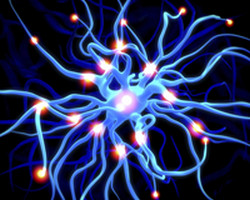Molecular basis of neural transmission
In recent years, significant progress has been made in understanding how signal transmission between neurons can increase in strength. Known as long term potentiation (LTP), this phenomenon has received much attention as a potential therapy for various neurodegenerative disorders. During LTP, strong activation of the N-methyl D-aspartate receptors on a presynaptic neuron leads to a cascade of events. These events culminate in an increase in glutamate AMPA receptors in the post-synaptic neuron. This in turns increases the release of neurotransmitters and prolongs the transmission of the signal. Although considerable work has been performed on the mechanisms responsible for synaptic strengthening, very few studies address which mechanisms are responsible for maintaining LTP. With this in mind, scientists on the EU-funded 'Regulation of AMPA type of glutamate receptor surface diffusion by protein kinase' (AMPAZETA) project wished to study the molecular events which regulate excitatory synapses in the hippocampus. Two proteins, namely protein kinase Mzeta (PKMZ) and Pin1 were recently found to be essential for LTP in hippocampal synapses. AMPAZETA researchers aimed to further elucidate the molecular mechanism by which Pin1 exerts its impact. In this context, they combined single-molecule imaging with molecular biology and single cell electrophysiology techniques. The project's experimental outline encompassed assays to determine the impact of Pin1 on AMPA receptor surface diffusion, dendritic spine morphology, and postsynaptic density protein 95 levels. Inhibition of Pin1 affected the aforementioned processes, rendering it a potential target for manipulating excitatory synapse formation, maintenance and synaptic plasticity. Pin1 plays a key role in age-dependent neurodegeneration and regulates the processing of amyloid precursor protein in Alzheimer's disease. The work by the AMPAZETA initiative improves our understanding of the molecular mechanisms that regulate synapse formation and LTP under physiological conditions. This information could lead to the development of new targets to reverse or ameliorate the effects of this neurodegenerative disorder.







